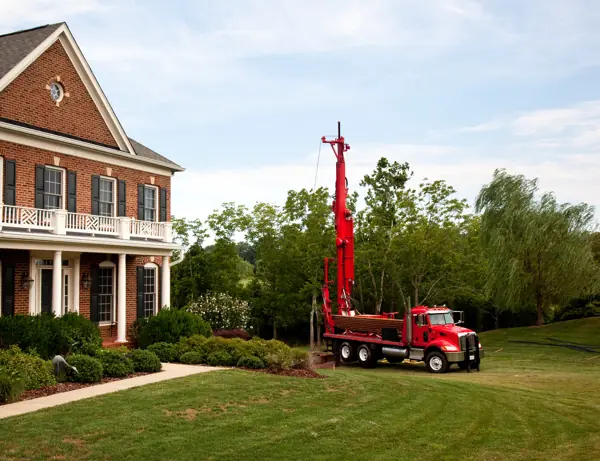Have you ever wondered what it takes to turn on a faucet and have crystal-clear water flow out? Well, it all starts with the well drilling process. This in-depth look at this complicated procedure will explain exactly what goes into having an accessible source of clean drinking water for your home.
So if you’re looking for insight into how drillers safely tap fresh sources of groundwater – read on!
The Necessary Preparations for a Successful Well Drilling
If you are planning to drill a well on your property, you’ll need to make some necessary preparations to ensure a successful drilling operation. Drilling a well demands careful planning and execution as the success of your project depends on various factors.
Here are some preparations you need to make before drilling a well:
1. Permitting: Before you start drilling, it’s essential to secure all the necessary permits. Depending on your location, you may need to obtain permits from the local government, homeowners association, or well drilling organization.
2. Choose a drilling site: The location of your well is crucial, so you must choose a spot with the help of a professional geologist. They can determine the best place to drill based on the soil type, surface water flow, and other factors.
3. Clear the area: The drilling site must be cleared of any obstacles, including trees, rocks, and other debris. A cleared area will make it easier for the drilling equipment to access the site.
4. Check for utilities: Before drilling, you need to confirm the location of any utility lines like gas, electricity, and water. This will prevent damage to the lines during drilling and reduce unnecessary costs.
5. Choose a drilling company: Once you have everything set, you should choose a well drilling company that has a good reputation for delivering quality services. The drilling company should have reliable equipment, experienced personnel, and insurance coverage.
6. Budget: Finally, you need to consider the costs associated with drilling a well. Ensure you have a realistic budget that covers all the expenses, including the cost of the permit, drilling equipment, labor, and any unforeseen expenses.
Hence, drilling a well requires proper planning to ensure a successful operation. By following the above preparations, you can ensure that your drilling project runs smoothly and meets your expectations. Remember to choose a reliable drilling company to ensure that you get the best value for your money.
Understanding the Terrain, Water Table, and Ground Conditions for Optimum Well Performance
One of the critical factors that determine the performance and efficiency of a well is the understanding of the terrain, water table, and ground conditions. Before drilling a well, it is essential to assess the geological conditions of the site to ensure that the well is installed in a location that provides sufficient water supply.
The terrain of the site plays a crucial role in determining the water flow to the well. The surface topography can affect how water flows through the ground and enters the well.
For instance, flat areas may not have enough water flow to meet the needs of a large well, while a slope may offset the supply of a well and cause it to go dry. Therefore, a thorough analysis of the terrain is necessary to identify the most suitable location for a well.
Another critical factor to consider is the water table. The water table refers to the level at which the water is found beneath the ground surface. The depth of the water table determines the drilling depth of the well and the possibility of tapping into an adequate water supply. A deeper water table may require a different type of well to be drilled, such as a deep well, to ensure that it reaches the water source.
Finally, ground conditions play a crucial role in determining the type of well and the materials used during construction. Different types of soils and rock formations have varying permeability and water retention characteristics, affecting the rate and volume of water that can flow into the well.
The identification of the ground conditions can provide insight into the drilling methods and materials to use, ensuring that the well is installed correctly and is capable of providing the required water supply.
Geological assessments must be completed to obtain the necessary information about the site’s characteristics, which inform the selection of the appropriate drilling method, well design, and materials needed. Obtaining expertise from professionals in the field is highly recommended to ensure that the well is installed efficiently and capable of providing a dependable and long-lasting water supply.
Essential Steps During Well Drilling Process and How to Monitor It Effectively
Drilling a well is a complex process that requires careful planning and monitoring from start to finish. Here are some key steps involved in drilling a well:
1. Choosing a drilling location: Before you can drill a well, you need to choose the right location. A good location will have an adequate supply of water, easy access for machinery, and be free from obstructions such as trees or buildings.
2. Site preparation: Once you have chosen a location, you need to prepare the site for drilling. This includes clearing the site of any obstructions, leveling the area, and installing any necessary infrastructure.
3. Drilling the well: This involves using a drilling rig to drill down into the ground to reach the water source. The drilling process can take several days to complete, depending on the depth of the well.
4. Installing the casing: A casing is installed to prevent the well from collapsing and to keep contaminants out. The casing is typically made of PVC or steel and is installed into the well using cement.
5. Installing the pump: After the casing has been installed, the pump is installed. The pump is responsible for pumping water out of the well and into your home or business.
Now that you understand the essential steps involved in drilling a well, it’s important to know how to monitor the process effectively. Here are some tips:
1. Hire a reputable drilling company: Choosing a reliable drilling company is key to ensuring that the drilling process is monitored effectively. A good drilling company will have experienced drillers who can identify any potential problems and recommend solutions.
2. Stay informed: Make sure to keep in touch with the drilling company throughout the process and ask for regular updates on the progress of the well. This will help you stay on top of any issues that may arise.
3. Conduct regular water tests: Once the well is completed, it’s important to conduct regular water tests to ensure that the water is safe to drink. You can either conduct the tests yourself or hire a professional to do it for you.
4. Monitor the well’s performance: After the well is up and running, it’s important to monitor its performance to ensure that it’s producing an adequate supply of water. Regular checks can help identify any issues early on before they become major problems.
5. Schedule regular maintenance: To keep your well operating smoothly, it’s important to schedule regular maintenance with your drilling company. This can include things like cleaning the well, replacing the pump or other components, and checking for any signs of damage.
By following these essential steps and monitoring the drilling process effectively, you can ensure that your well provides a reliable source of water for years to come.
The Importance of Proper Cleanup After Well Drilling is Complete
After well drilling is complete, it is crucial to take proper steps to ensure that the site is left clean and safe. Failure to do so can result in environmental harm, legal penalties, and even injury or death to those working in the area.
One of the primary concerns during well drilling is the risk of contamination from drilling mud and fluids. These fluids can contain harmful chemicals and heavy metals that can leach into the soil and groundwater if not disposed of properly. To prevent this, it is important to contain and dispose of all drilling fluids according to local regulations.
Another important step in proper cleanup is to remove any debris or waste materials left over from drilling. This can include leftover PVC piping, drill cuttings, and other materials. These items can cause physical hazards, such as tripping and falling, as well as potential environmental harm if left on the site.
Proper restoration of the area is also an important part of cleanup after well drilling. This includes filling in any holes or depressions created during drilling and restoring the area to its natural state as much as possible. This helps to prevent erosion and maintain the local ecosystem.
It is important to work with experienced and qualified professionals to ensure that proper cleanup procedures are followed after well drilling. This includes hiring a licensed drilling contractor and environmental consultant to oversee the process and ensure that all applicable regulations are followed.
Do You Need A Reliable Well Drilling Service?
A professionally drilled well offers you year-round access to water for your home or business. With professional well drilling services, you can ensure that your well is properly installed and maintained, guaranteeing access to clean, safe water. Feel free to contact us at Well Doctor LLC for safe and expert well drilling service.
Invest in professional well drilling today — get started with our team of experts now!

